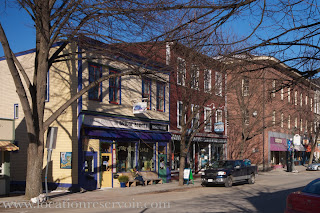(This image is located at: http://locationreservoir.wordpress.com/2012/07/20/when-hollywood-takes-over-a-small-new-england-village-pt-2/ . I selected this image to represent a small village or city as referred in the narrative below.)
As a trickster and provocateur, I
am proposing the juxtaposition of two hypothetical cities: one which prohibits
guns and another that requires guns to be carried by all people. In light of the current gun control debate
brought about by the tragedy of Newtown, Connecticut, a discussion as the one
below is warranted. The metaphors of utopia (or dis-utopia) is useful when
discussing issues. The most concrete way
to discuss utopias is within the context of a city, which has been used by
urbanists for centuries (i.e., Plato, Sir Thomas Moore. ) I will discuss this within a fictional
situation of the two hypothetical cities.
At the beginning of 2013, the city council of one city in the U.S. decided that the ultimate solution to violence was the arming of all people above the age of eighteen in its jurisdiction. Even visitors would be required to carry a gun. Those opposing it had no choice, but to either abide by the ordinance or to leave the city. This seemed like the perfect solution. Later, they determined that there must be mandatory gun training. What about people who were elderly? Should they be allowed to carry guns when their vision and some had mental stability was questionable? Also, what about people with some form of mental illness? In turn, they enacted a regulation to screen those who were mentally incapable of owning a firearm. Then, one day a person came into town with a machine gun and killed about fifty people. The council decided maybe everyone should now have machine guns so that they would be equal. What about those who could not afford machine guns? It was concluded that that this was their problem. The premise was that things could be resolved with guns; no matter the level of conflict. This resulted in more gun tragedies related to domestic violence. When one man was fired from a job, he shot his boss before he could reach for his gun. Of course, he was killed by other workers. It was resolved that even though there was increased violence that everyone was safer.
Another city, not too far away from
the ‘gun toting city’ passed an ordinance to ban all guns from their city. The city council resolved that no one could
have a gun, even law enforcement. This
required gathering all guns and disposing of them. Anyone caught entering the city with a
firearm would be jailed, fined and sent out of the city. Those that opposed to this ordinance would be
required to leave the city. This was not
a problem as a nearby city allowed guns for everyone. There were organizations formed on counseling
people how to resolve issues without violence. Everyone was happy with the situation. Police were able to solve problems of
burglary, domestic abuse, and accidents without using firearms. A sense of community based on a culture of
non-violent resolution of conflicts.
Then, one day a person with a gun was able to come into the city and
managed to rob a store, killing the manager and some of the customers. Citizens were shaken as they thought that they
had done everything to prevent violence.
They began to reconsider their banning of all guns. Would they have to go back to the armed
security guards, gun ownership etc.?
Ultimately, they resolved that there would have to be walls with barbed
wires around the city; and restricted and guarded entry gates with armed police,
even at their small airport.
This hypothetical situation is symbolic of the division that our country is enduring. No one could dispute that the ever reoccurring mass killings is a tragedy. Yet, it also goes on in smaller cases almost daily. We have on one hand a radical segment that would ban handguns, automatic weapons, and assault weapons and make stringent regulations on buying a gun to those who want greater freedom to purchase guns. Both sides interpret the Second Amendment in two diametrically different manners.
Urban areas are where the majority of gun violence occurs. It is the responsibility of the Federal, State or city/county government to curtail gun violence at the local level? What is the right mix of regulations that curtain gun violence and be acceptable to most people? What is apparent is that we as a nation are polarized on this issue to the point of paralysis. Differing opinions vary by households, neighborhoods and cities within different parts of the U.S. But, we have to develop a dialog and not one of bullying one opinion over another. “Shouting matches” never resolve in good solutions.





